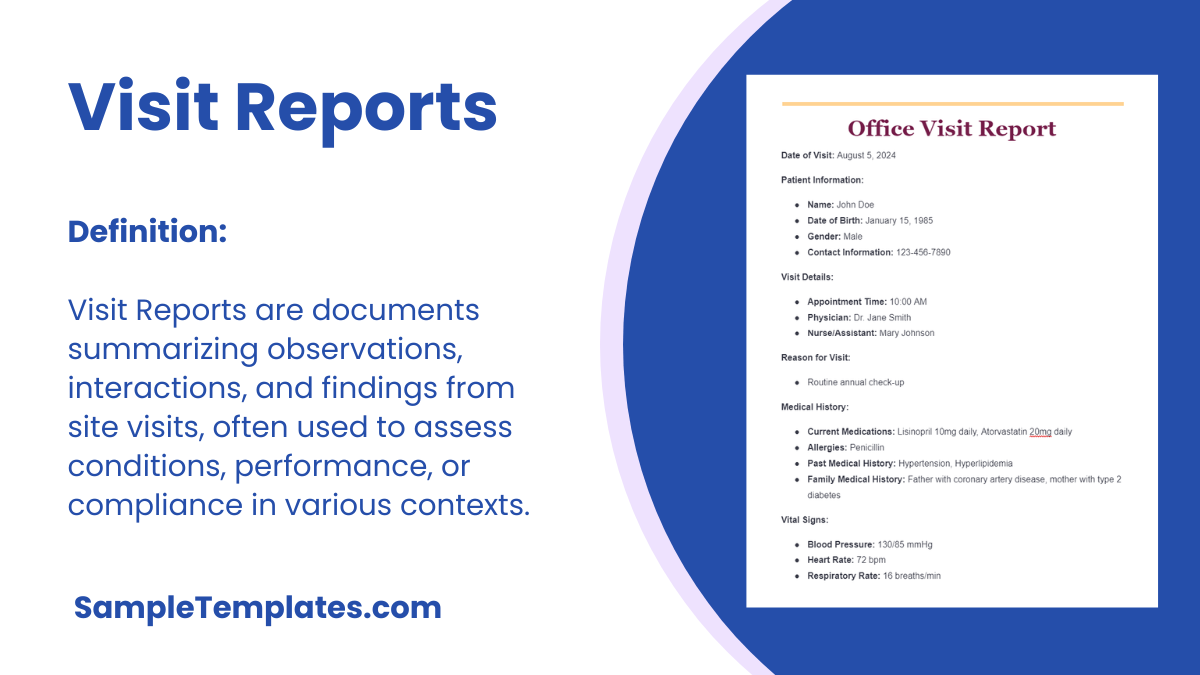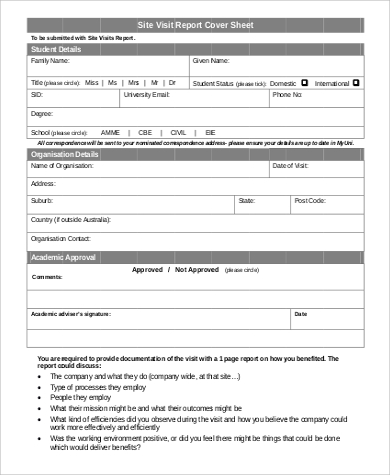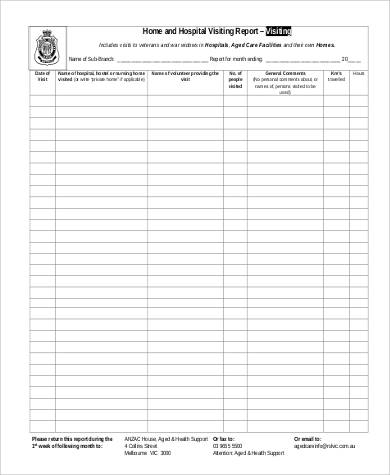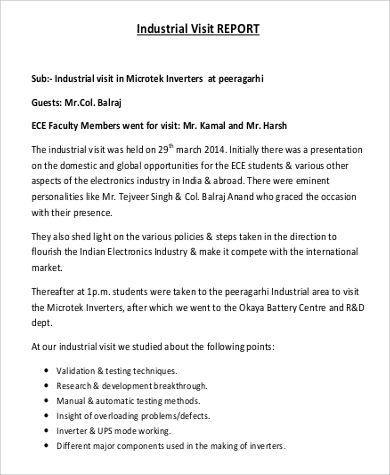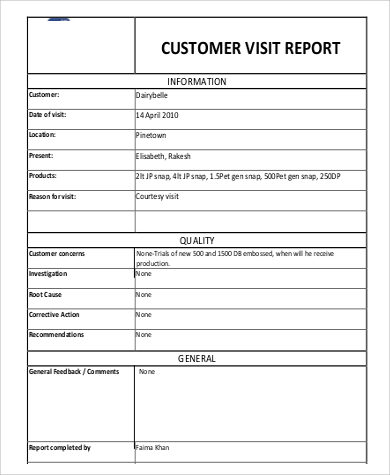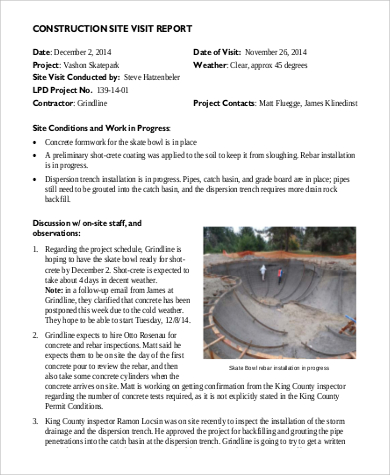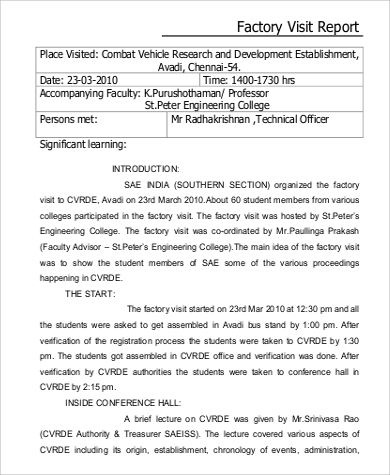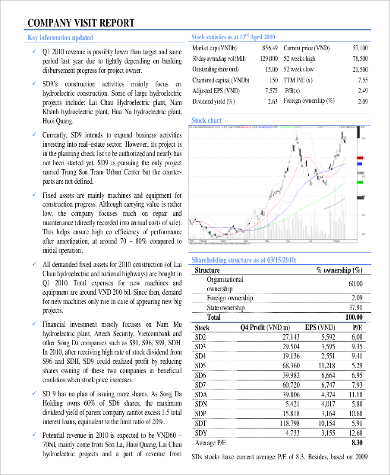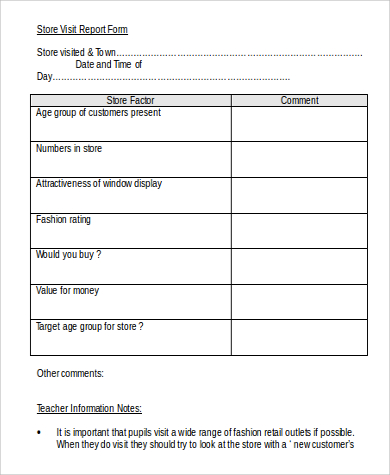One of the most beloved stories for children is “Little Red Riding Hood.” It is the story of a girl who is going to visit her sick grandmother. She comes across a big bad wolf. There are many versions, all of which she gets eaten by the wolf.
Although the ending of the story itself is a little extreme for a story for kids, they love the story because the main character is a kid who loves her grandmother. It is relatable, minus the wolf in the forest of course. Perhaps, if Little Red was not eaten, she could have relayed her tragic visit to the police. The point of this article is the visit report. Below are Sample Reports you can check out and download for free.
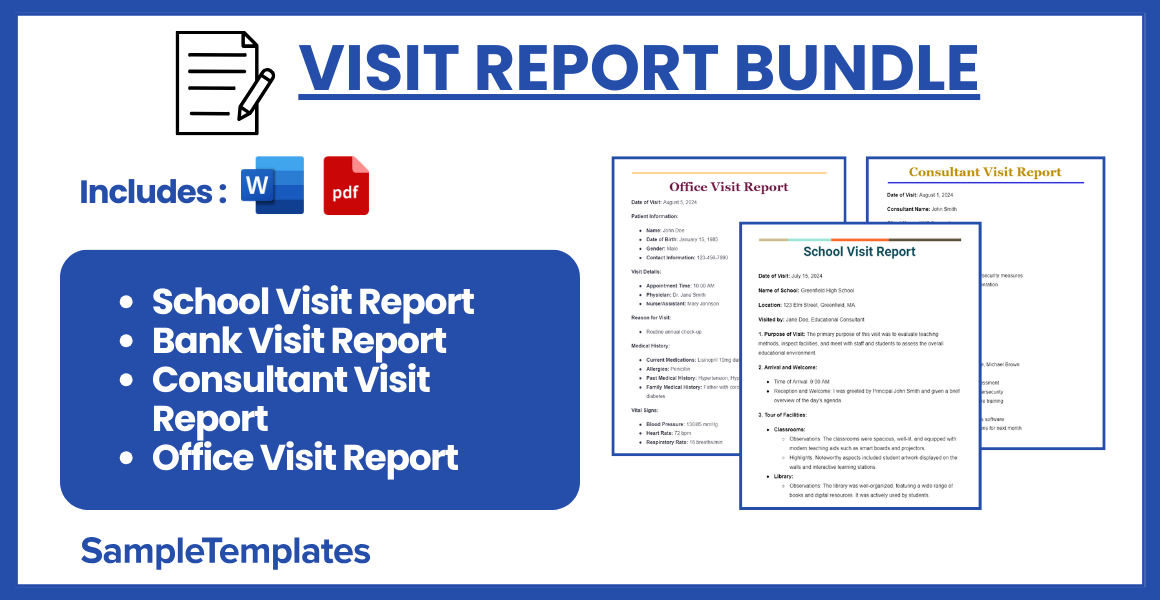
School Visit Report
Date of Visit: July 15, 2024
Name of School: Greenfield High School
Location: 123 Elm Street, Greenfield, MA
Visited by: Jane Doe, Educational Consultant
1. Purpose of Visit: The primary purpose of this visit was to evaluate teaching methods, inspect facilities, and meet with staff and students to assess the overall educational environment.
2. Arrival and Welcome:
- Time of Arrival: 9:00 AM
- Reception and Welcome: I was greeted by Principal John Smith and given a brief overview of the day’s agenda.
3. Tour of Facilities:
- Classrooms:
- Observations: The classrooms were spacious, well-lit, and equipped with modern teaching aids such as smart boards and projectors.
- Highlights: Noteworthy aspects included student artwork displayed on the walls and interactive learning stations.
- Library:
- Observations: The library was well-organized, featuring a wide range of books and digital resources. It was actively used by students.
- Highlights: Special programs like the reading club and a digital resource center were impressive.
- Laboratories:
- Observations: The science and computer labs were well-maintained and stocked with up-to-date equipment.
- Highlights: The advanced chemistry lab and the integration of coding lessons in the computer lab were commendable.
- Sports Facilities:
- Observations: The school had extensive sports facilities, including a large gymnasium, a football field, and tennis courts.
- Highlights: Unique features included a swimming pool and a state-of-the-art fitness center.
- Cafeteria:
- Observations: The cafeteria was clean, spacious, and offered a variety of healthy food options.
- Highlights: The school’s farm-to-table meal program was particularly impressive.
4. Meeting with Staff and Administration:
- Key Personnel Met: Principal John Smith, Vice Principal Emily Davis, Head of Science Department Dr. Michael Brown
- Discussion Points:
- Curriculum advancements and integration of technology in teaching
- Strategies for improving student performance and engagement
- Challenges faced due to recent budget cuts
- Plans for future development and facility upgrades
5. Interaction with Students:
- Activities Observed: Observed a biology class, a coding workshop, and the school’s debate club session.
- Student Feedback: Students expressed satisfaction with the teaching methods and facilities. They appreciated the extracurricular opportunities and the support from teachers.
6. Key Observations and Findings:
- Strengths:
- Innovative teaching methods and use of technology in classrooms
- Strong emphasis on extracurricular activities and sports
- Active involvement of students in various programs and clubs
- Areas for Improvement:
- Need for more funding to support advanced lab equipment
- Potential for expanding the library’s digital resource offerings
7. Conclusion and Recommendations:
- Summary: The visit to Greenfield High School was highly positive, showcasing a well-rounded educational environment with strong community and student involvement.
- Recommendations:
- Secure additional funding for lab upgrades
- Expand digital resources in the library
- Continue to develop and support extracurricular programs
8. Additional Notes: The school’s commitment to sustainability through its farm-to-table program is exemplary and could serve as a model for other schools.
Report Prepared by:
Jane Doe
Educational Consultant
July 16, 2024
Signature:
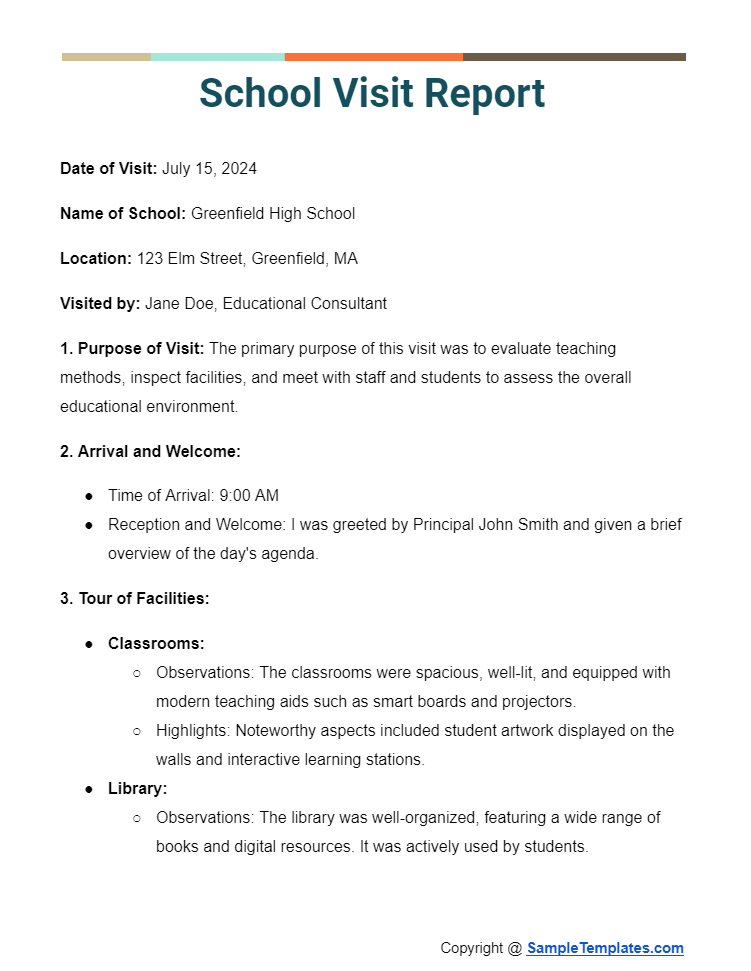
Bank Visit Report
Date of Visit:
August 5, 2024
Bank Name:
First National Bank
Branch Location:
123 Main Street, Springfield, MA 01103
Purpose of Visit:
To inquire about loan options, open a new checking account, and discuss the bank’s financial products and services.
Time of Visit:
10:00 AM – 11:30 AM
Meeting Summary
Attendees:
- Bank Representative:
- Jane Doe, Loan Officer
- John Smith, Account Manager
- Visitor:
- [Your Name]
Topics Discussed:
- Loan Options:
- Types of Loans:
- Personal Loans
- Home Equity Loans
- Auto Loans
- Small Business Loans
- Interest Rates:
- Fixed and variable rates discussed.
- Current promotional rates for new customers.
- Loan Terms:
- Short-term and long-term repayment options.
- Penalties for early repayment.
- Eligibility Criteria:
- Minimum credit score requirements.
- Necessary documentation for application.
- Types of Loans:
- New Checking Account:
- Account Types:
- Basic Checking
- Premium Checking
- Student Checking
- Fees and Charges:
- Monthly maintenance fees.
- Overdraft protection fees.
- ATM usage fees.
- Account Benefits:
- Interest-bearing accounts.
- Online banking features.
- Mobile deposit and bill pay options.
- Required Documentation:
- Proof of identity.
- Social Security Number.
- Proof of address.
- Account Types:
- Financial Products and Services:
- Savings Accounts:
- Interest rates on savings and money market accounts.
- Investment Options:
- Certificates of Deposit (CDs).
- Retirement accounts (IRAs).
- Brokerage services.
- Credit Cards:
- Various credit card options with different rewards programs.
- Insurance Products:
- Life insurance.
- Homeowners and auto insurance.
- Savings Accounts:
Action Items:
- Loan Application:
- Collect necessary documentation for a personal loan application.
- Schedule a follow-up meeting with Jane Doe to submit the loan application.
- Opening a New Checking Account:
- Gather required documents to open a Premium Checking account.
- Schedule an appointment with John Smith for account setup.
- Further Inquiries:
- Research investment options discussed and schedule a consultation with the bank’s financial advisor.
Observations:
- The bank branch was clean, well-organized, and followed health and safety protocols.
- The staff was professional, courteous, and knowledgeable.
- The wait time was minimal, and the overall experience was positive.
Recommendations:
- For Loans:
- Consider the current promotional rates and compare them with other banks to ensure the best deal.
- Ensure all required documents are prepared in advance to expedite the loan application process.
- For Checking Account:
- Evaluate the benefits of the Premium Checking account against its monthly fees to determine if it meets your financial needs.
- For Financial Products:
- Take advantage of the bank’s financial advisory services to get personalized investment advice.
Conclusion:
The visit to First National Bank was productive and provided valuable insights into their loan options, checking accounts, and other financial products. Further action is needed to complete the loan application and open a new checking account.
Report Prepared by:
[Your Name]
Date:
August 5, 2024
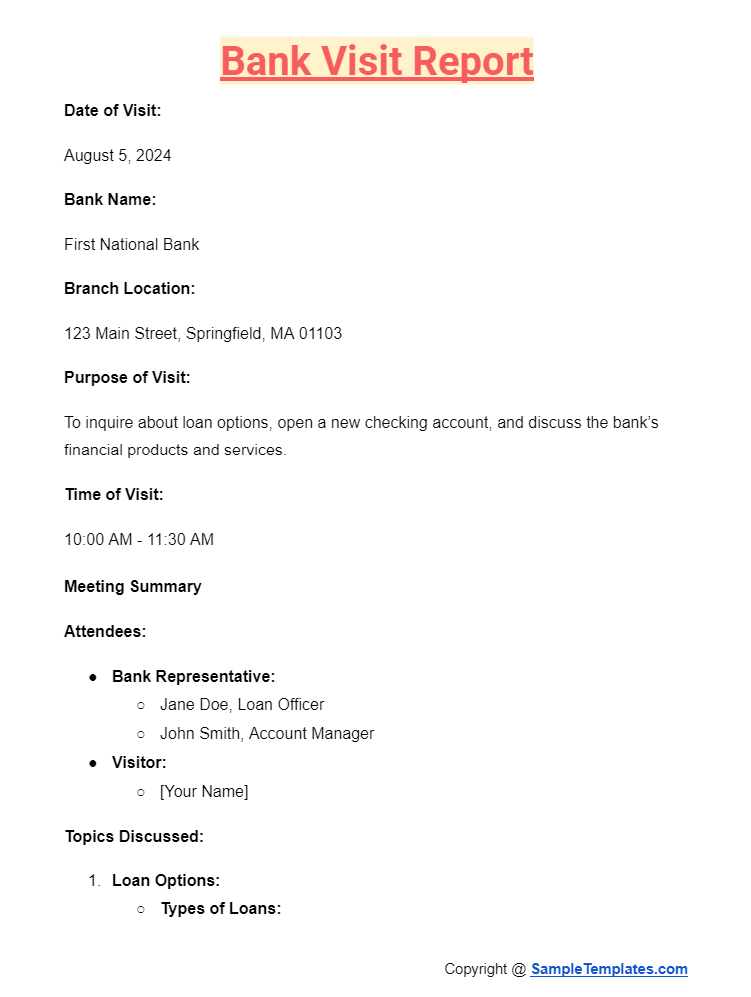
Consultant Visit Report
Date of Visit: August 1, 2024
Consultant Name: John Smith
Client Name: XYZ Corporation
Location: 123 Main Street, Springfield, IL
Objectives of the Visit
- Evaluate current IT infrastructure
- Discuss potential upgrades to cybersecurity measures
- Train staff on new software implementation
Summary of Activities
- Arrival Time: 9:00 AM
- Departure Time: 4:30 PM
Meetings Conducted
Meeting 1:
- Participants: John Smith, Jane Doe, Michael Brown
- Topics Discussed:
- Current IT infrastructure assessment
- Identified weaknesses in cybersecurity
- Proposed timeline for software training
- Key Decisions:
- Upgrade firewall and antivirus software
- Schedule staff training sessions for next month
Meeting 2:
- Participants: John Smith, IT Department
- Topics Discussed:
- Detailed review of existing systems
- Specific cybersecurity threats faced by the company
- Customization of new software for company needs
- Key Decisions:
- Immediate patch updates for all systems
- Customized software modules to be developed by the end of the quarter
Observations
- Observation 1: Current firewall is outdated and unable to handle modern threats.
- Observation 2: Staff is unfamiliar with new software features.
- Observation 3: Some hardware components are near end-of-life and need replacement.
Issues Identified
- Issue: Outdated Firewall
- Impact: High risk of cybersecurity breaches
- Recommended Action: Replace with updated firewall solutions
- Issue: Lack of Staff Training on New Software
- Impact: Decreased productivity and potential for errors
- Recommended Action: Conduct comprehensive training sessions
Recommendations
- Upgrade Firewall:
- Rationale: To protect against modern cybersecurity threats
- Expected Outcome: Enhanced security and reduced risk of breaches
- Staff Training on New Software:
- Rationale: Improve efficiency and reduce errors
- Expected Outcome: Increased productivity and software utilization
- Replace Aging Hardware:
- Rationale: Prevent hardware failures and ensure reliability
- Expected Outcome: More stable and reliable IT infrastructure
Next Steps
- Upgrade Firewall:
- Responsible Party: IT Department
- Due Date: August 15, 2024
- Schedule Training Sessions:
- Responsible Party: HR Department
- Due Date: August 10, 2024
- Hardware Replacement Plan:
- Responsible Party: Procurement Team
- Due Date: August 30, 2024
Attachments
- Attachment 1: IT Infrastructure Assessment Report
- Attachment 2: Cybersecurity Threat Analysis
- Attachment 3: Training Schedule and Materials
Consultant Signature:
John Smith
Senior IT Consultant
john.smith@example.com
Client Acknowledgment:
Jane Doe
IT Manager, XYZ Corporation
jane.doe@xyzcorp.com
Date of Report: August 2, 2024
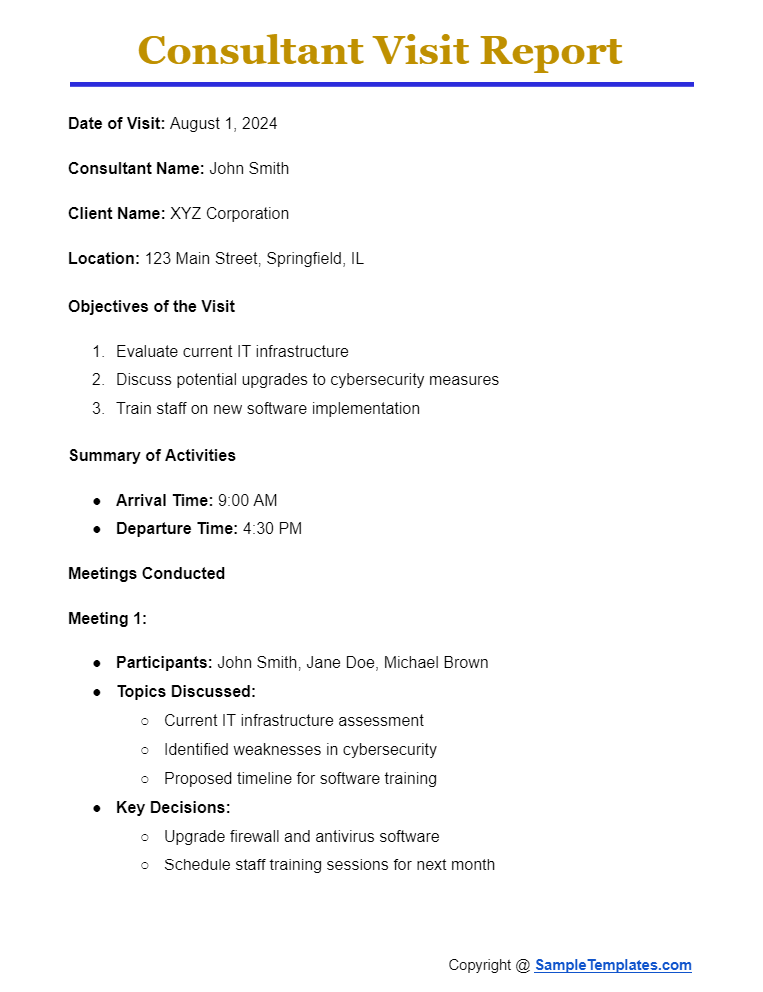
Office Visit Report
Date of Visit: August 5, 2024
Patient Information:
- Name: John Doe
- Date of Birth: January 15, 1985
- Gender: Male
- Contact Information: 123-456-7890
Visit Details:
- Appointment Time: 10:00 AM
- Physician: Dr. Jane Smith
- Nurse/Assistant: Mary Johnson
Reason for Visit:
- Routine annual check-up
Medical History:
- Current Medications: Lisinopril 10mg daily, Atorvastatin 20mg daily
- Allergies: Penicillin
- Past Medical History: Hypertension, Hyperlipidemia
- Family Medical History: Father with coronary artery disease, mother with type 2 diabetes
Vital Signs:
- Blood Pressure: 130/85 mmHg
- Heart Rate: 72 bpm
- Respiratory Rate: 16 breaths/min
- Temperature: 98.6°F
- Weight: 180 lbs
- Height: 5’10”
- BMI: 25.8
Physical Examination:
- General Appearance: Well-nourished, no acute distress
- Head and Neck: No lymphadenopathy, thyroid normal
- Cardiovascular: Regular rate and rhythm, no murmurs
- Respiratory: Clear to auscultation bilaterally
- Abdomen: Soft, non-tender, no hepatosplenomegaly
- Musculoskeletal: Full range of motion, no swelling or tenderness
- Neurological: Alert and oriented, cranial nerves intact
- Skin: No rashes or lesions
Laboratory and Diagnostic Tests:
- Tests Ordered: CBC, Lipid panel, HbA1c
- Results: Pending
Assessment and Plan:
- Assessment:
- Hypertension, controlled
- Hyperlipidemia, controlled
- Plan:
- Continue Lisinopril 10mg daily
- Continue Atorvastatin 20mg daily
- Follow-up in 6 months for blood pressure and lipid panel recheck
- Referral to dietitian for dietary counseling
- Patient education on lifestyle modifications (diet, exercise)
Notes:
- Patient advised to monitor blood pressure at home and keep a log
- Discussed importance of regular exercise and a heart-healthy diet
Physician’s Signature: ____________________________
Date: August 5, 2024
Patient’s Signature: ____________________________
Date: August 5, 2024
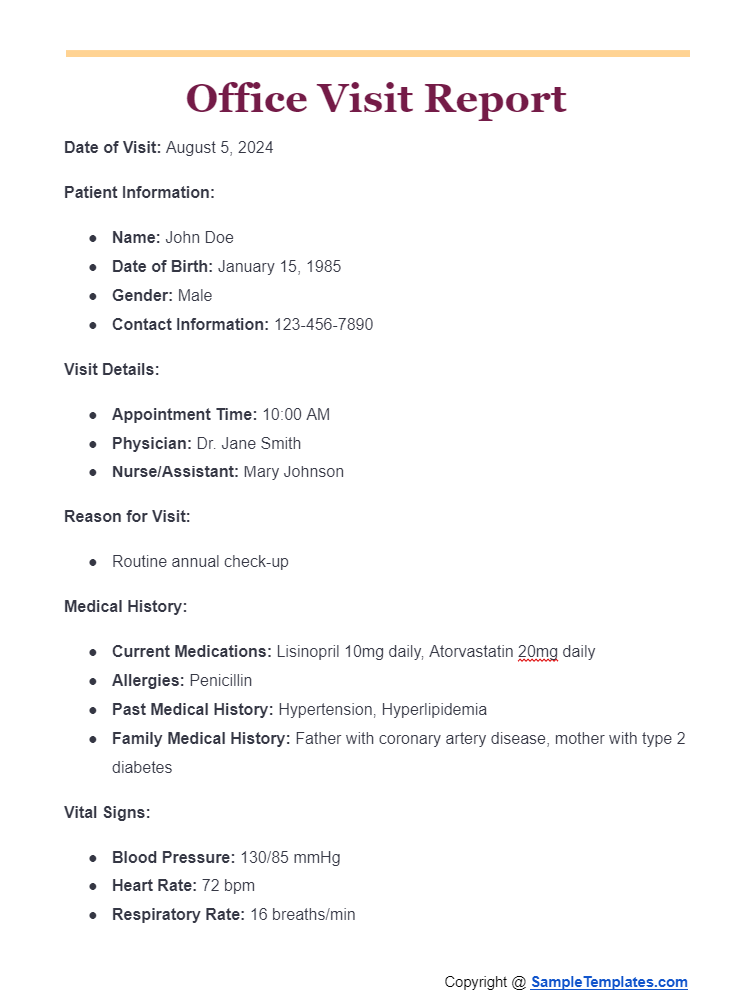
Browse More Templates On Visit Report
Customer Visit Report
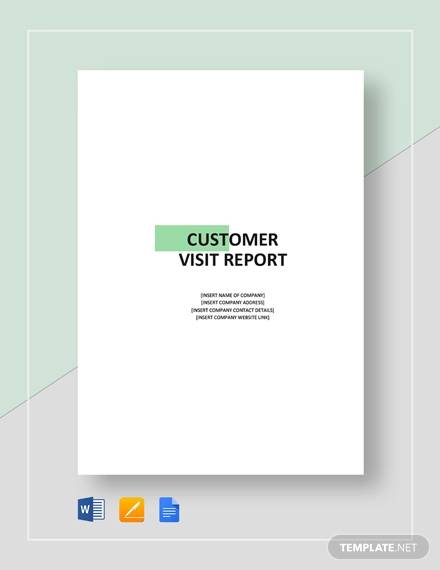
Site Visit Report Template Word Free
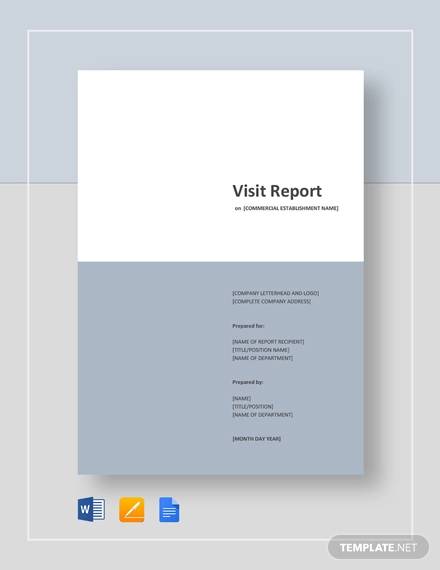
Site Visit Report Template Word
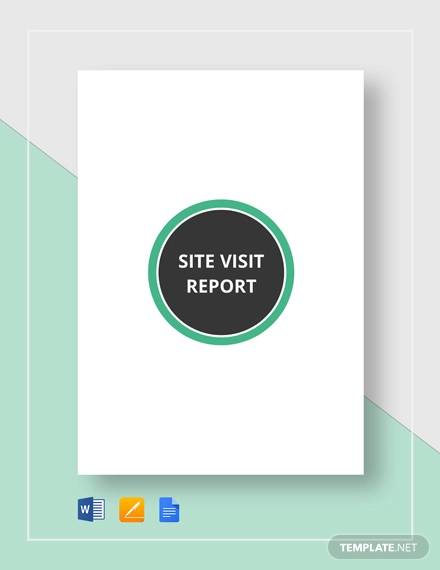
How To Write a Visit Report?

- Title and Date:
- Begin with a clear title that indicates the purpose of the visit and the date when the visit occurred.
- Introduction:
- Provide an introduction that outlines the purpose of the visit, the location, and the parties involved. Mention the objectives and scope of the visit. You can also see more on Business Visit Report.
- Summary:
- Offer a brief summary of the visit, highlighting the main findings and conclusions. This provides readers with an overview before they delve into the details.
- Detailed Description:
- Describe the activities and observations made during the visit in detail. Include relevant background information and context for better understanding.
- Observations:
- Document specific observations, including any noteworthy occurrences, conditions, or behaviors. Use clear and precise language to ensure accuracy.
- Analysis:
- Analyze the observations, discussing their significance and implications. Relate your findings to the objectives of the visit and provide context. You can also see more on School Visit Report.
- Photos and Visuals:
- Include photographs, diagrams, or charts if applicable. Visual aids can enhance understanding and provide additional context.
- Recommendations:
- Provide recommendations based on your findings. Suggest actions, improvements, or follow-up visits if necessary.
- Conclusion:
- Summarize the key points of the report, reiterating the main findings and their implications. Conclude with any final thoughts or remarks.
- Appendices and References:
- Attach any supplementary materials, such as detailed data, charts, or additional notes, in appendices. Cite any references or sources used in the report. You can also see more on Trip Report.
Field Visit Report Template
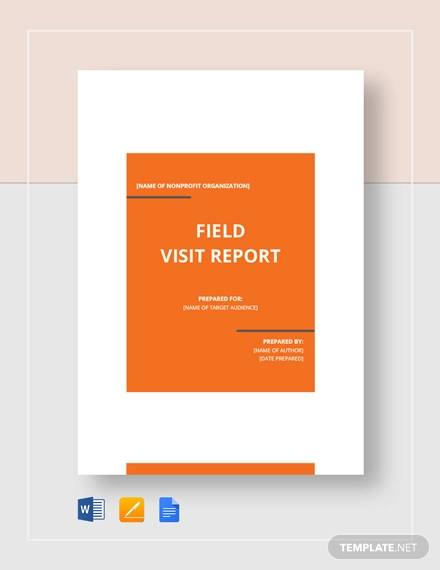
Customer Visit Report Format

Site Visit Report Template Free Download
How Do you Write a Market Visit Report?
Writing a market visit report involves documenting observations, insights, and findings gathered during a visit to a specific market or location. Here’s a guide on how to structure and write a comprehensive market visit report:
- Title and Date: Start with a clear title indicating the purpose of the market visit, along with the date of the visit. You can also see more on Clinical Trip Report.
- Introduction: Provide a brief introduction outlining the objective of the market visit and any relevant background information. Clearly state the purpose of the report.
- Market Overview: Describe the market’s location, size, and key characteristics. Include details such as the type of market (retail, wholesale, online), its target audience, and any notable features.
- Objectives of the Visit: Clearly outline the specific goals and objectives of the market visit. This could include researching competitors, assessing customer behavior, or evaluating product placement.
- Pre-Visit Research: Summarize any research conducted before the visit, such as market trends, competitor analysis, or customer demographics. This provides context for your observations. You can also see more on Field Report.
- Observations and Findings: Detail your observations during the visit. This may include insights on product displays, pricing strategies, customer interactions, competitor activities, and overall market trends.
- Competitor Analysis: Evaluate the presence and strategies of competitors in the market. Note their product offerings, pricing, promotions, and any unique selling points.
- Customer Behavior: Analyze customer behavior, preferences, and demographics. Consider aspects such as purchasing patterns, customer inquiries, and feedback.
- Challenges and Opportunities: Identify any challenges or opportunities observed during the market visit. This could include areas for improvement, potential collaborations, or emerging market trends.
- Recommendations: Based on your findings, provide actionable recommendations for the business or organization. These could include marketing strategies, product enhancements, or operational improvements.
- Conclusion: Summarize the key points discussed in the report and restate the significance of the market visit. Emphasize any immediate actions that should be taken.
- Attachments: Include any supporting documents, photographs, or additional materials that complement the report.
- Acknowledgments: Express appreciation to individuals or organizations that facilitated the visit.
- Contact Information: Provide your contact information in case there are questions or further clarification is needed.
Ensure that your report is well-organized, concise, and provides actionable insights for stakeholders. Use clear and professional language, and tailor the report format to suit the preferences of your audience.
Visit Report Example
What is the report format?
A report format typically includes the following elements: title, date, introduction, methodology (if applicable), main findings or content organized into sections, conclusions, recommendations, and any necessary attachments or appendices. It follows a structured layout to present information in a clear, organized, and easily understandable manner for the intended audience.
Industrial Visit Report Format
Site Visit Report Template Free Download
Field Visit Report Template
Uses of Visit Report
- Documentation:
- Provides a detailed record of the visit, including observations, activities, and findings for future reference.
- Communication:
- Facilitates clear and comprehensive communication between stakeholders about the visit’s purpose and outcomes. You can also see more on Company Reports.
- Assessment:
- Evaluates conditions, processes, or performance at the visited site, helping in identifying strengths and areas for improvement.
- Decision-Making:
- Informs decision-making by providing critical insights and data collected during the visit.
- Compliance:
- Ensures that regulatory or organizational standards are being met through documented inspections and evaluations.
- Planning:
- Assists in planning future actions, projects, or visits based on the findings and recommendations documented in the report.
- Accountability:
- Holds individuals or teams accountable for their actions and performance by providing an objective account of the visit.
- Progress Tracking:
- Monitors the progress of ongoing projects or initiatives, offering a basis for comparison with previous reports and identifying trends over time. You can also see more on Survey Reports.
Customer Visit Report Template Free Download
Site Visit Report Sample
Factory Visit Report Sample
Formal Company Visit Report Template
Tips For Writing a Visit Report
- Prepare in Advance:
- Before the visit, outline the objectives and gather any necessary background information. This preparation helps focus your observations and ensures you don’t miss important details. You can also see more on Business Report Writing.
- Take Detailed Notes:
- During the visit, take thorough and organized notes. Capture key observations, interactions, and any relevant details that will be useful for the report.
- Be Objective:
- Maintain objectivity in your observations and reporting. Present facts and evidence without bias, ensuring the report remains professional and credible.
- Use Clear and Concise Language:
- Write in a clear and concise manner. Avoid unnecessary jargon and complex sentences. Ensure that your report is easily understandable by the intended audience.
- Include Visuals:
- Use photographs, diagrams, or charts to support your observations and findings. Visual aids can enhance comprehension and provide additional context.
- Organize Logically:
- Structure your report with clear headings and sections. A logical flow helps readers follow your narrative and understand the key points.
- Review and Edit:
- Proofread your report for grammatical errors, typos, and inconsistencies. Revising ensures clarity and coherence, making your report more professional.
- Provide Recommendations:
- Based on your observations, offer actionable recommendations. Suggest specific steps or improvements that can be made, adding value to your writing report.
Visit Report Form in Word
Home Visit Report Writing Example
How does one write a Visit Report?
One can write an effective visit report in the following manner:
- Look over the requirements of your visit
- Start the report with basic and general information about the visit
- Define the purpose of your visit
- Explain what happened during your visit in a sequential order
- Summarize all the operations at the site.
What must be included in a Trip Visit Report?
A trip visit report is one of the most common parts of organizational communication. It follows the format of a basic memorandum. It must include the following details in it:
- Reason for the trip
- What was found during the course of the trip
- Any other conclusions
- Sample Budget for the trip, etc.
General FAQs
1. What is a Visit Report?
A visit report is a document that essay outlines information regarding an individual’s visit to a specific site to observe and collect information. Visit reports can be defined as a report that different people write, depending on the visit made by them. It gives details of the visit.
2. What is the purpose of a Visit Report?
The purpose of a visit report is to obtain additional documentation plan for the report. Before the visit, the project team must prepare a checklist for the evaluation group based on the self-evaluation reports. This process will ensure that any uncertainties in the self-evaluation reports are identified specifically.
3. What is the format of a Report?
Sample Reports are split into parts with headings and subheadings. They can be academic, business-oriented or technical, depending on the situation. Reports are mainly written to present facts about a situation, project or process and they analyze the issue that is at hand.
4. What is the aim of the visit report?
The aim of a visit report is to document and communicate observations, findings, and outcomes from a particular visit. It serves as a comprehensive record for analysis, decision-making, and future planning.
5. What should be included in a visit report?
A visit report should include details on the purpose, date, and location of the visit, observations made, key findings, encountered challenges, recommendations, and a concise summary of the overall visit.
Final Thoughts:
Visiting sites is another avenue for you to learn something. The learning experience is furthermore concretized through your report. Your teachers want you to be able to gain not only knowledge but skills as well, that is why you are encouraged to go out and learn in the process.
A philosopher named John Dewey popularized the educational concept, “learning by doing.” He believes that students can learn more when they have a share in the class activity. Visiting sites is a classic example of Dewey’s philosophy. Sure, we can learn a lot from reading and listening to lectures, but the experience is different when we can do things. And if you are looking for more sample reports, we have a lot, like sample accident reports.
Related Posts
FREE 6+ Incident Analysis Report Samples in PDF
Psychological Assessment Report Samples [ Clinical, Child, Intake ]
FREE 6+ Food Incident Report Samples [ Safety, Poisoning, Service ]
FREE 11+ Student Performance Report Samples [ Medical, Academic, Class ]
FREE 10+ Land Appraisal Report Samples in PDF
FREE 10+ Work Accident Report Samples [ Vehicle, Injury, Safety ]
FREE 10+ Desk Research Report Samples in PDF
FREE 5+ Post-Security Incident Report Samples in PDF
FREE 10+ Service Quality Report Samples [ Project, Customer, Performance ]
FREE 10+ Weekly Project Status Report Samples in MS Word | Google Docs | Pages | PDF
Building Inspection Report
SEO Report
Teachers Weekly Report Samples & Templates [ Accomplishment, Duty, Work ]
FREE 10+ Business Recommendation Report Samples in PDF | DOC
FREE 10+ Leadership Report Samples [ Development, Training, Camp ]
